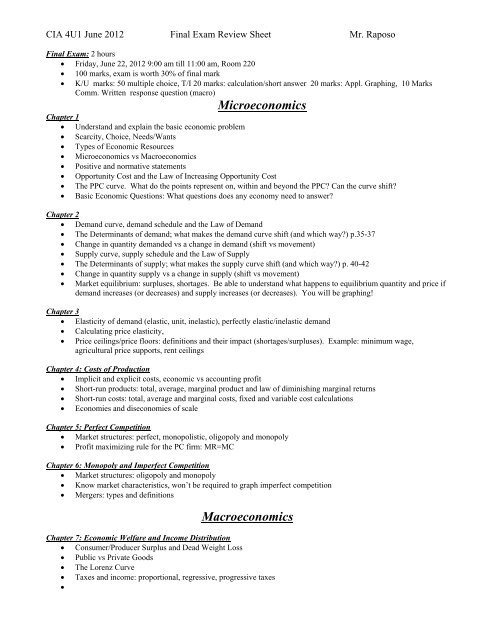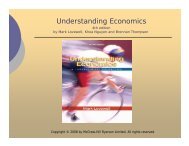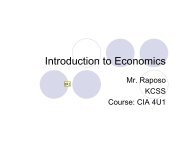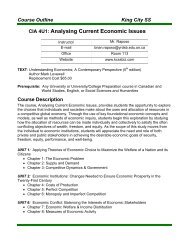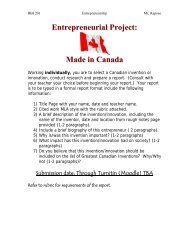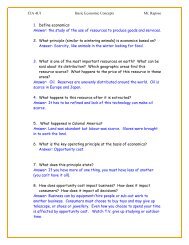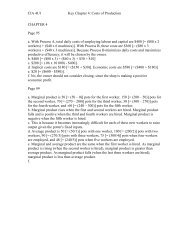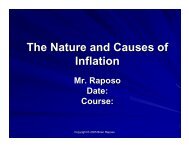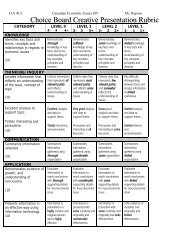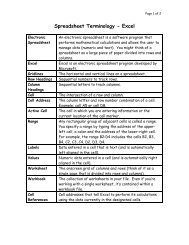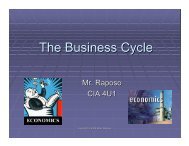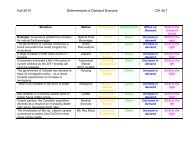Final Exam Review Sheet
Final Exam Review Sheet
Final Exam Review Sheet
You also want an ePaper? Increase the reach of your titles
YUMPU automatically turns print PDFs into web optimized ePapers that Google loves.
CIA 4U1 June 2012 <strong>Final</strong> <strong>Exam</strong> <strong>Review</strong> <strong>Sheet</strong> Mr. Raposo<br />
<strong>Final</strong> <strong>Exam</strong>: 2 hours<br />
• Friday, June 22, 2012 9:00 am till 11:00 am, Room 220<br />
• 100 marks, exam is worth 30% of final mark<br />
• K/U marks: 50 multiple choice, T/I 20 marks: calculation/short answer 20 marks: Appl. Graphing, 10 Marks<br />
Comm. Written response question (macro)<br />
Microeconomics<br />
Chapter 1<br />
• Understand and explain the basic economic problem<br />
• Scarcity, Choice, Needs/Wants<br />
• Types of Economic Resources<br />
• Microeconomics vs Macroeconomics<br />
• Positive and normative statements<br />
• Opportunity Cost and the Law of Increasing Opportunity Cost<br />
• The PPC curve. What do the points represent on, within and beyond the PPC? Can the curve shift?<br />
• Basic Economic Questions: What questions does any economy need to answer?<br />
Chapter 2<br />
• Demand curve, demand schedule and the Law of Demand<br />
• The Determinants of demand; what makes the demand curve shift (and which way?) p.35-37<br />
• Change in quantity demanded vs a change in demand (shift vs movement)<br />
• Supply curve, supply schedule and the Law of Supply<br />
• The Determinants of supply; what makes the supply curve shift (and which way?) p. 40-42<br />
• Change in quantity supply vs a change in supply (shift vs movement)<br />
• Market equilibrium: surpluses, shortages. Be able to understand what happens to equilibrium quantity and price if<br />
demand increases (or decreases) and supply increases (or decreases). You will be graphing!<br />
Chapter 3<br />
• Elasticity of demand (elastic, unit, inelastic), perfectly elastic/inelastic demand<br />
• Calculating price elasticity,<br />
• Price ceilings/price floors: definitions and their impact (shortages/surpluses). <strong>Exam</strong>ple: minimum wage,<br />
agricultural price supports, rent ceilings<br />
Chapter 4: Costs of Production<br />
• Implicit and explicit costs, economic vs accounting profit<br />
• Short-run products: total, average, marginal product and law of diminishing marginal returns<br />
• Short-run costs: total, average and marginal costs, fixed and variable cost calculations<br />
• Economies and diseconomies of scale<br />
Chapter 5: Perfect Competition<br />
• Market structures: perfect, monopolistic, oligopoly and monopoly<br />
• Profit maximizing rule for the PC firm: MR=MC<br />
Chapter 6: Monopoly and Imperfect Competition<br />
• Market structures: oligopoly and monopoly<br />
• Know market characteristics, won’t be required to graph imperfect competition<br />
• Mergers: types and definitions<br />
Macroeconomics<br />
Chapter 7: Economic Welfare and Income Distribution<br />
• Consumer/Producer Surplus and Dead Weight Loss<br />
• Public vs Private Goods<br />
• The Lorenz Curve<br />
• Taxes and income: proportional, regressive, progressive taxes<br />
•
CIA 4U1 June 2012 <strong>Final</strong> <strong>Exam</strong> <strong>Review</strong> <strong>Sheet</strong> Mr. Raposo<br />
Chapter 8: Measures of Economic Activity<br />
• Know what national income accounts are<br />
• Define GDP, GDP per capita and understand the limitations of GDP<br />
• What causes economic growth? (Land, Labour, Capital, Entrepreneurship/Technology)<br />
• The benefits/costs of economic growth (open letter from a “Growth Man/Non-Growth Man”<br />
Chapter 9: Inflation and Unemployment<br />
• Define inflation, deflation and hyperinflation<br />
• What does CPI stand for and how is it measured?<br />
• Calculate inflation over a given year with CPI provided<br />
• Unemployment: Types of unemployment, definitions and examples<br />
• What is full employment and the natural rate of unemployment?<br />
Chapter 10: Economic Fluctuations<br />
• Define aggregate demand (AD) and understand how increases (decreases) shift the AD curve<br />
• Define aggregate demand (AS) and understand how increases (decreases) shift the AS curve<br />
• Correctly label and understand the interaction of AD and AS, the impact on price levels and output and identify the<br />
potential output target level<br />
• Draw and label the business cycle, identifying when contractionary and expansionary fiscal policy is required<br />
Chapter 11:Fiscal Policy<br />
• Understand stabilization policy, understand expansionary and contractionary shifts in AD<br />
• Understand automatic stabilizers<br />
• Understand and calculate the multiplier effect, marginal propensity to consume (MPC), marginal propensity to<br />
withdraw (MPW) and the spending multiplier<br />
• Know what budget deficits, budget surpluses and balanced budgets are and how they relate to Canada’s most<br />
recent Federal Budget<br />
• Label the “leaky bucket” and explain its relevance to economics<br />
Chapter 12:Money (upto p.331)<br />
• List, explain and provide an example of the functions of money<br />
• Understand the definitions of the supply of money<br />
• Able to relate Money supply/interest rates<br />
Chapter 13:Monetary Policy<br />
• Monetary Policy: expansionary and contractionary<br />
• Demand Pull and Cost Push inflation<br />
• The role of the Bank of Canada<br />
Chapter 14 & 15:International Trade)<br />
• Exchange rates/appreciation/depreciation<br />
• Fixed vs Floating/flexible exchange rates<br />
• Imports/exports, current account, capital account


